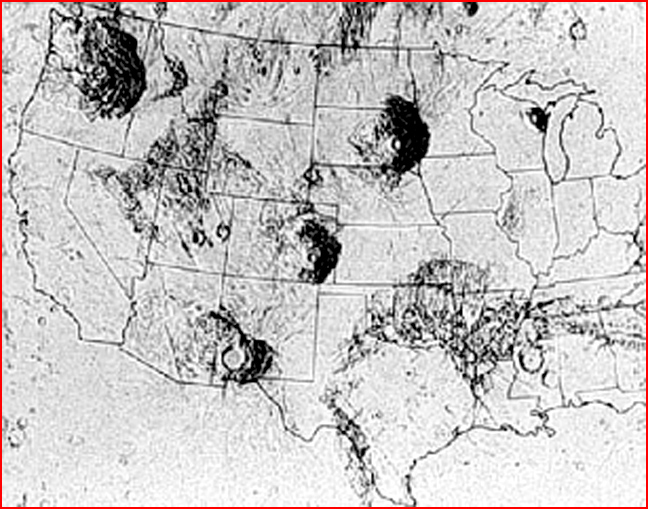
home •
about •
essential guide •
picture of the day •
thunderblogs •
news •
multimedia •
predictions •
products •
get involved •
contact
picture of the day archive subject index
The Tharsis volcanoes superimposed on a map of the United States. Credit: NASA The Red Planet # 10
Oct 24, 2007
The Tharsis Montes Volcanoes
Volcanoes on Mars should not be found in chains similar to those on Earth since no crustal plate movement exists there. Could electricity be a factor?
Scientists from the University of Arizona and the Goddard Space Flight Institute recently announced that the volcanoes located in the Tharsis Montes region on Mars might not be extinct after all. Because the four gigantic craters are near one another and three of them run in a chain, scientists thought that they must have been created in the same way that standard theories explain crater chains.According to the lead author of a paper appearing in Geophysical Research, Jacob Bleacher, that might not be how it happens on Mars. Olympus Mons, Ascraeus Mons, Pavonis Mons and Arsia Mons could have a moving column of magma beneath them.
Volcanoes on Earth form when the plates that make up the Earth's crust move over upwelling magma plumes, according to standard theories. Rising magma naturally seeks out the weakest fractures that allow it to erupt onto the surface, or under the ocean. Island chains may appear if enough lava deposits build up and create steep-sided mountains whose tops break the waves.
On Mars, however, there is no evidence that the crust moves. No plate boundaries exist so there should be no line of volcanoes similar to the Hawaiian Islands, for instance. In order to explain the Tharsis anomaly, Bleacher and his colleagues have postulated that the plume of magma is what moved rather than the crust.
"We thought we could take what we learned about lava flow features on Hawaiian volcanoes and apply it to Martian volcanoes to reveal their history. The problem was that until recently, there were no photos with sufficient detail over large surface areas to reveal these features on Martian volcanoes. We finally have pictures with enough detail from the latest missions to Mars, including NASA's Mars Odyssey and Mars Global Surveyor, and the European Space Agency's Mars Express missions."
In previous Thunderbolts Picture of the Day articles about the Martian volcanoes, Olympus Mons in particular, we theorized that the shape of the escarpments and the surrounding topography indicates that they could have been made by enormous plasma discharges that impacted the planet. The force of the electric current raised the giant mounds and carved out their distinctive calderas.
As Electric Universe theorist Wal Thornhill points out:
"Olympus Mons, 25 kilometres high, is NOT the highest volcano in the Solar System. It is a giant raised electrical blister with characteristic superimposed circular craters at the summit. It is the kind of blister seen on metal lightning arrestor caps after a strike."
If electric currents of such magnitude influenced the geography of Mars, could they have done something similar on Earth? Is it the theory of plate tectonics and its relationship to volcanism on our planet that should be reconsidered, rather than inventing a new theory because new observations do not support the old one?
Written by Stephen Smith from an idea submitted by Michael Goodspeed
___________________________________________________________________________Please visit our Forum
The Electric Sky and The Electric Universe available now!

|
|

|
EXECUTIVE EDITORS:
David Talbott, Wallace Thornhill
MANAGING EDITORS:
Steve Smith, Mel Acheson
CONTRIBUTING EDITORS: Michael Armstrong, Dwardu Cardona,
Ev Cochrane,
C.J. Ransom, Don Scott, Rens van der Sluijs, Ian Tresman
WEBMASTER: Brian Talbott
Copyright 2007: thunderbolts.info
![]()
home •
thunderblogs •
forum •
picture of the day •
resources •
team •
updates •
contact us

